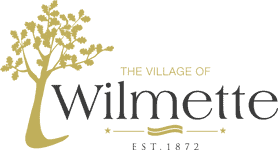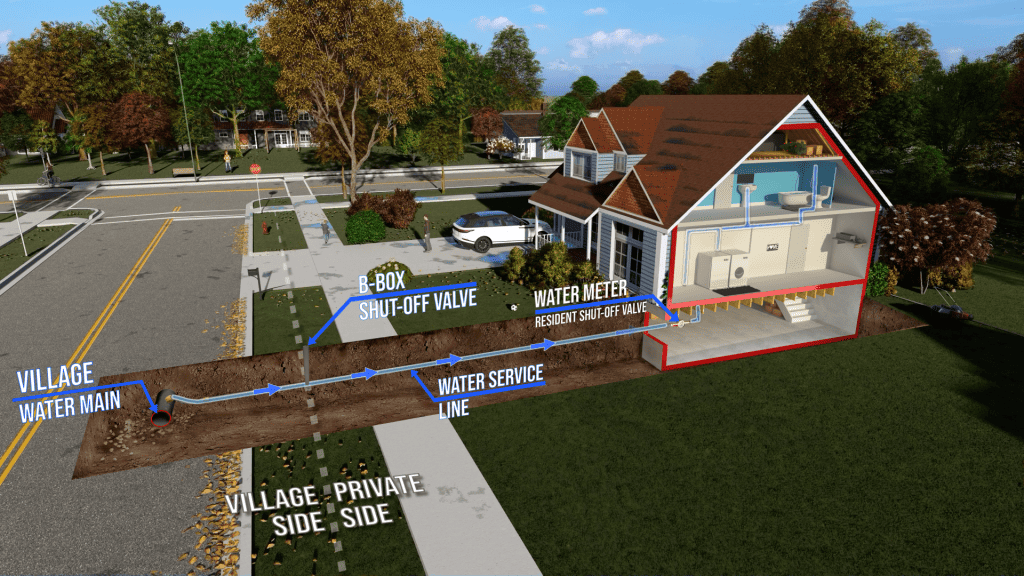A water service connects the public water main (usually under the street) to your home or business. Service line ownership is shared between the Village and property owners. Wilmette owns the portion from the public water main to the B-Box or shut-off valve, and the property owner owns the portion from the B-Box or shut-off valve into the house.
In 1988, the use of lead water service lines was banned completely by the federal government. In homes not served by a lead water service line, the most common source of lead in water is plumbing and plumbing fixtures with lead in them. Plumbing and plumbing fixtures could be sold as “lead-free” until 2014, but could contain up to 8% lead.
The lead levels, if any, are completely unique to each home due to its plumbing materials, such as the presence of lead solder or brass faucets, fittings and valves that may contain lead. Our treatment works to keep corrosion of pipes as low as possible (corrosive water can cause lead to leach from plumbing materials that contain lead) and there are actions you can take to reduce exposure.
Generally, there are three sources that could leach lead into the drinking water:
Lead Service Lines
- A service line is the pipe that connects your house to the water main in the street. Some service lines that run from older homes (usually those built before 1940) to the utility water main are made from lead. Over time, some of these older service lines have been replaced, but many homes could still have one.
Lead-tin solder joined copper pipes
- Copper piping has often been used since the 1930’s for home plumbing, but the solder (an alloy of tin with lead and antimony) used to fuse the pipes together typically contained elevated levels of lead prior to 1986, the year it was banned.
Household faucets and fixtures
- Lead can also corrode from metal faucets and fixtures made from brass, an alloy of copper and zinc that often contains lead impurities, including chrome-plated brass fixtures. Therefore, a home with no copper or lead pipe may still have elevated lead levels due to brass fixtures. Plumbing fixtures with a lead content of less than 8% used to be legally defined as “lead free” but since 2014, “lead free” refers to fixtures with a lead content of 0.25% or less.
Please check with your certified plumber to identify any sources of lead in your home.
The best way to remove risks of lead in water is to completely replace all sources of lead. But there are also steps you can take right away to reduce lead levels in your water. We strongly urge you to take the steps below to reduce your exposure to lead in drinking water.
- Run the Tap Before Use
Lead levels are likely at their highest when water has been sitting in a lead pipe for several hours. Clear this water from your pipes by running the cold water for 3-5 minutes before using. This allows you to draw fresh water from the Village’s water main. In efforts to conserve water, you can use this water on house plants or to flush toilets.
- Clean Aerators
Aerators are small attachments at the tips of faucets which regulate the flow of water. They can accumulate small particles of lead in their screens. It’s a good idea to remove your aerators at least monthly and clean them out.
- Use Cold Water for Cooking and Drinking
Always cook and prepare baby formula with cold water, because hot water dissolves lead more quickly, resulting in higher levels in water.
- Filter the Water
Many home water filters are effective at removing lead. If you purchase a filter, make sure it is certified to NSF/ANSI 53 and NSF/ANSI 42 for lead reduction and that you maintain it properly. Find out more on filter certification at www.nsf.org.
- Do Not Boil
Boiling water will not reduce lead.
- Identify Fixtures
Identify your plumbing fixtures that contain lead and replace them with lead free fixtures.

